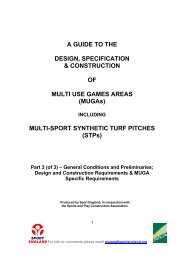View - North East Lincolnshire Council
View - North East Lincolnshire Council
View - North East Lincolnshire Council
Create successful ePaper yourself
Turn your PDF publications into a flip-book with our unique Google optimized e-Paper software.
BOC Immingham Dissolved Acetylene Project Environmental Statement: Vol. 2 Main Text<br />
Assessment Methodology and Significance<br />
Criteria<br />
Legislation and Policy<br />
Air Quality Strategy<br />
6.5 The UK Government’s Air Quality Strategy (AQS) for England, Scotland, Wales and <strong>North</strong>ern<br />
Ireland 22 provides details of national air quality standards and objectives for a number of local air<br />
pollutants. These statutory criteria are defined in Regulations SI 2000/928 and SI 2002/3043.<br />
6.6 The standards define the level of pollution below which health effects are unlikely to be<br />
experienced even by the most sensitive members of the population. These are based upon the<br />
recommendations of the Expert Panel on Air Quality Standards (EPAQS). The objectives are<br />
targets for air pollution concentrations which take account of the costs and benefits of achieving<br />
the standard. In the case of short-term targets, the permissible number of hours or days above the<br />
objective concentration is also specified. The number of permissible ’exceedences’ is considered<br />
when determining compliance with the short-term objectives over an annual period.<br />
6.7 The AQS objectives also implement the requirements of European Directives on air quality. The<br />
first European Community (EC) air pollution limit values were introduced in the 1980s. The<br />
directives contain mandatory limit values that must be attained and more stringent, but nonobligatory,<br />
guide values. In April 2008, the European Commission adopted a directive on ambient<br />
air quality and cleaner air for Europe (2008/50/EC). This directive merged the previous Air Quality<br />
Framework Directive and the first three daughter directives and introduced new objectives for<br />
PM2.5. It has recently been transposed into UK Regulations (SI 2010/1001).<br />
6.8 It should be noted that the UK air quality objectives only apply in locations where there may be a<br />
‘relevant exposure’. These human health objectives are applicable where members of the public<br />
may be exposed to pollutant levels for periods equal to or exceeding the averaging periods set for<br />
these criteria. Locations of relevant exposure include building façades of residential premises,<br />
schools, public buildings and medical facilities. Places of work (other than certain community<br />
facilities) are excluded.<br />
6.9 The air quality objectives for the protection of human health and for the protection of vegetation<br />
and ecosystems, relevant to transport emissions, are presented in Table 6.1.<br />
Ecosystems<br />
6.10 The objectives set for the protection of ecosystems apply in areas that are:<br />
� more than 20 km from towns with more than 250,000 inhabitants; or<br />
� more than 5 km from industrial sources regulated under Part 1 of the Environmental<br />
Protection Act 1990, motorways and built up areas of more than 5,000 people.<br />
6.11 Nevertheless, the regulatory agencies have agreed with the countryside agencies that these<br />
objectives (also referred to as critical levels) should be applied at all locations as a matter of<br />
policy, and therefore they have been included in this study.<br />
6.12 Critical loads for nitrogen and acid deposition have been set by the United Nations Economic<br />
Commission for Europe (UNECE). A critical load is defined as a quantitative estimate of an<br />
exposure to one or more pollutants below which significant harmful effects on specified sensitive<br />
elements of the environment do not occur, according to present knowledge. Critical loads vary by<br />
type of habitat and species. The critical load for nitrogen deposition (eutrophication) is given as a<br />
range and is quoted in units of kg N/ha/year. A single critical load is quoted for acidification, in keq<br />
H + /ha/year. The critical load for acidification considers both nitrogen and sulphur deposition fluxes.<br />
5100935.404 Environmental Statement August 2011 71




